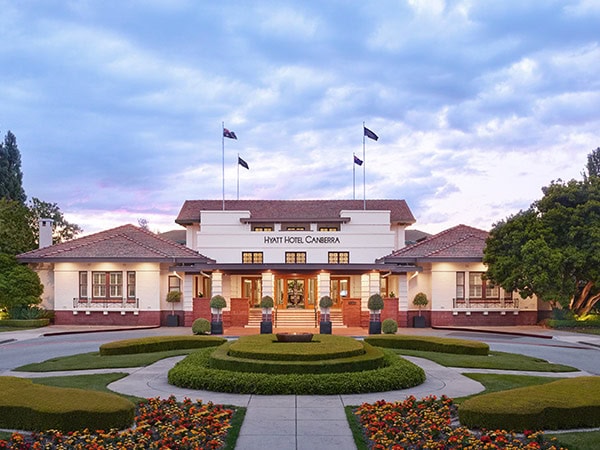For 100 years, the historic Hyatt Hotel Canberra – A Park Hyatt Hotel has been spoiling guests and luminaries from far and wide in laidback splendour. Here’s a look at what goes on inside this Canberra icon.
As one of the earliest buildings and the very first hotel in Canberra, what’s now known as the Hyatt Hotel Canberra has always made a significant mark on the landscape. It’s accommodated royalty, rock stars and a procession of heads of state through the decades, and still does to this day.
Designed by Commonwealth’s Architect, John Smith Murdoch, the luxe hotel opened in 1924 to accommodate parliamentarians and staff arriving in the fledgling capital, and soon became the social hub of the city. Using a layout in keeping with Canberra’s ‘garden city’ plan, it featured a series of pavilions and courtyards radiating out from the centre, all set in spacious grounds with tennis courts and a croquet lawn. This provided privacy and the feel of a country estate, a feeling that hasn’t been lost a century later.
After more than 50 years as a hotel (and then a short spell housing government offices) the hotel reopened in 1988 with aplomb. With a large seamless extension and a reinvigoration of its original glory, it became the Hyatt Hotel Canberra under the esteemed Park Hyatt brand – the first in Australia.
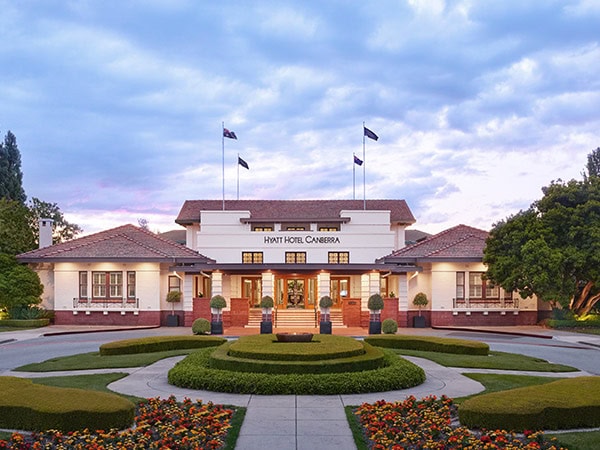
Read on for our Hyatt Hotel Canberra review.
Location
Given the hotel’s original remit to provide parliamentary accommodation, it’s not surprising both the old and the new Parliament Houses are just a stroll away. The National Triangle is also where Canberra’s iconic galleries and national institutions are located so there’s no shortage of things to do around the city nearby.
The shores of Lake Burley Griffin are straight out the back or walk across Commonwealth Bridge and you’re soon into the green oasis of Commonwealth Park, home of the annual Floriade festival of flowers, and the heart of the city.
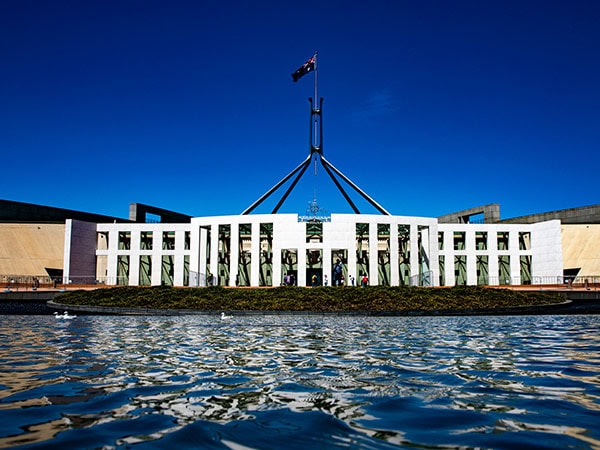
Take a short stroll to icons like Parliament House. (Image: Marcus Reubenstein)
Style and character
The moment I walk through the brick and stucco portico (porte cochere if you want to get formal) and through timber doors swung open by uniformed doormen, I’m transported to another era.
Perhaps it’s the spacious lobby with its hand-pressed decorated ceilings high above with lead light recesses even higher to let in the light. Maybe it’s the richly-hued original jarrah floorboards, the Art Deco finishes or the soft wafts of classical music floating in the air that carries me back in time. Whatever it is, it’s calm, relaxing and refined.
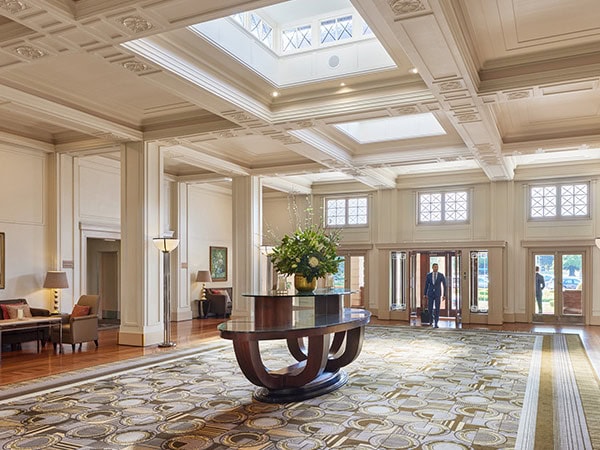
The hotel exudes elegance as soon as you step into the lobby.
Facilities
The Gardens
Acres of gardens surrounding the hotel were always an integral part of the design. The two courtyard gardens are havens: Rose Courtyard the place for lazy lunches, afternoon or evening tipples, and the Lavender Courtyard popular for intimate weddings.
Sipping an afternoon cocktail from the specially created cocktail list on the broad, covered verandah is an excellent choice of location. Though soaking up dappled sun under the shade of a sprawling maple is also recommended.
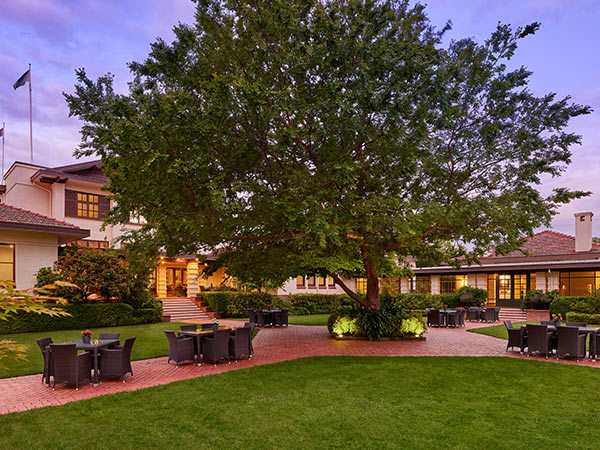
Gardens were reconstructed from the original plans.
From either, I can admire the impressive gardens, pleached camellias and box hedges marking out spaces around the lawns. Having been recreated from original plans and sketches, the gardens are close to the originals planned by horticulturist Charles Weston, the man largely responsible for the ‘greening’ of Canberra in the early 1900s to become ‘the Bush Capital’.
Bar and lounges
Inside I’m similarly spoilt for choice with secluded comfy spots to enjoy a quiet moment. There are a number of lounge areas, three of them sporting fireplaces, perfect for winter evenings. The Speakers’ Corner Bar, lined with photographic memorabilia, serves up whiskeys and cocktails while the Griffin room opposite offers lounge chairs and space for contemplation. Formerly the Smoking Room, the Howard Lounge offers yet another quiet alternative.
Luckily the thick smoke that would have filled the room has well and truly disappeared with only the hint of conspiratorial conversations that may have taken place here remaining.
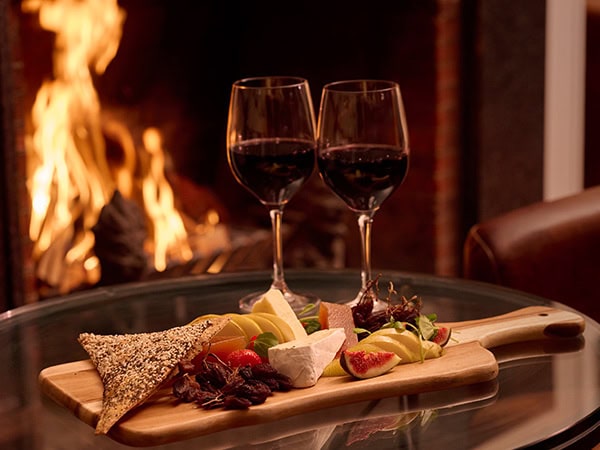
Curl up by the fireplace for a cosy evening.
The Clubhouse
I’m not usually one to avail myself of hotel gym facilities, but The Clubhouse here is sorely tempting. With a surprisingly large selection of gym equipment, treadmills, bikes and rowers, a separate weights room and a 15-metre edgeless pool (heated of course), it’s a rather stylish place to get some exercise. Open from 6am to 9pm, there’s a sauna to work up some sweat if you haven’t already done so. A range of gym classes are available, and bikes can be hired too.
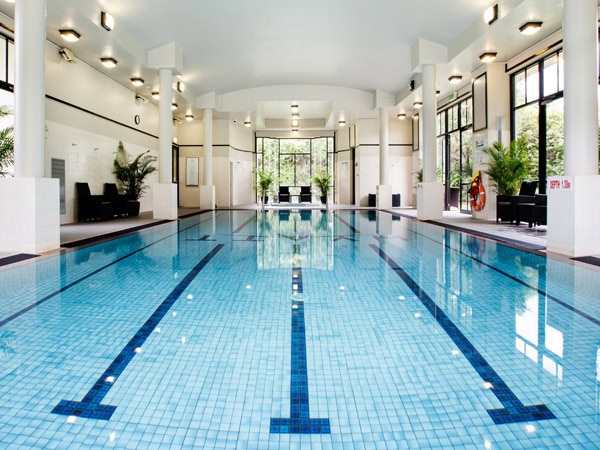
Dip into the pool for a relaxing and refreshing swim.
Rooms
There are 252 guest rooms including 13 spacious suites either in the front heritage section or the award-winning extension in the back section of the hotel. The diplomatic suites offer abundant space with separate lounge and dining areas, kitchenettes and opulent marble bathrooms.
I’m spoilt with a stay in The Scullin Suite, one of six diplomatic suites in the heritage section of the hotel, named for Prime Minister James Scullin who resided in the hotel with his wife during his tenure. Space abounds, which is not surprising as the suites were designed to be larger than the average apartments at the time, each coming in at 240 square metres.
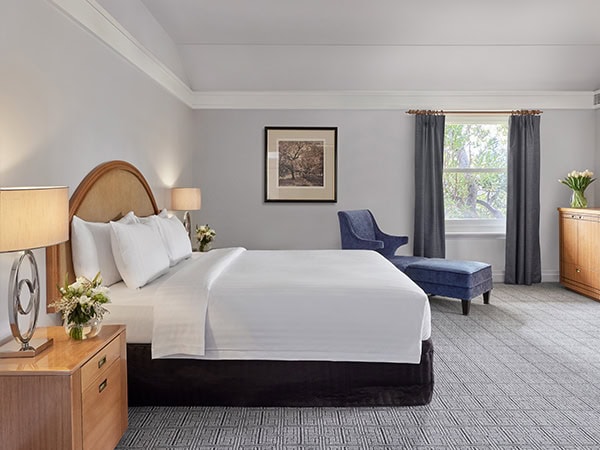
Diplomatic Suites were designed to be larger than the average apartments at the time.
With classic decor, an oversized lounge, a separate dining room and kitchenette, two balconies and even a walk-in robe, it feels like a home away from home. The opulent bathroom featuring the hotel’s signature black and white marble is a highlight, the spa bath at the top of three marble steps beckoning me to enter for a long soak, possibly with a movie on the side.
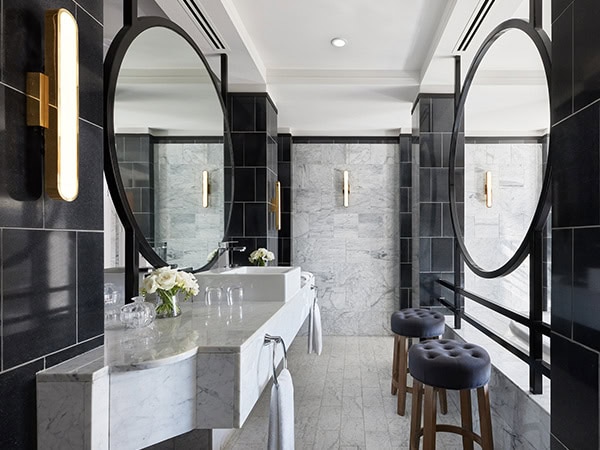
Even the bathrooms are gorgeous.
The king-size bed doesn’t disappoint, providing a fabulously comfortable sleep and dreamy pillows. Even the powder room is something to behold. With a broad selection of historic and eclectic reading material scattered in the lounge and in the bookcase, you hardly need to leave the suite. Though with so many other inviting spaces to explore in the hotel, that would be rather a pity.
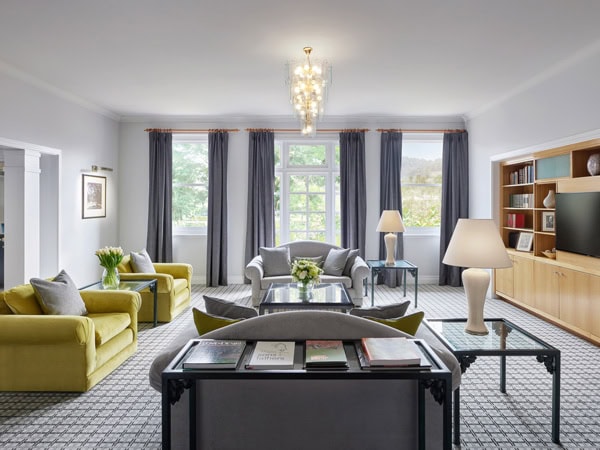
Book the Diplomatic Suite for a very stylish stay.
Smaller heritage rooms are available, as well as modern suites and rooms in the newer section of the hotel, combining modern luxuries with the classic style and elegance evident throughout the hotel.
Food and drink
The Tea Lounge is the convivial heart of the hotel. Here, under the sparkle of oversized rectangular chandeliers in the comfort of traditional club lounge seating, guests and visitors gather for coffee, drinks or to take part in the all-day dining options. It’s not just travellers who fill the lounges. It’s a spot beloved by locals for celebrating special occasions.
I’m here for high tea, served as it has been since the 1920s, a tiered feast of hot and cold, sweet and savoury treats. In elegant surrounds, I’m sipping bubbles and my chosen tea blend while working my way through an array of gorgeous little edible things displayed before me. I’m in my happy place.
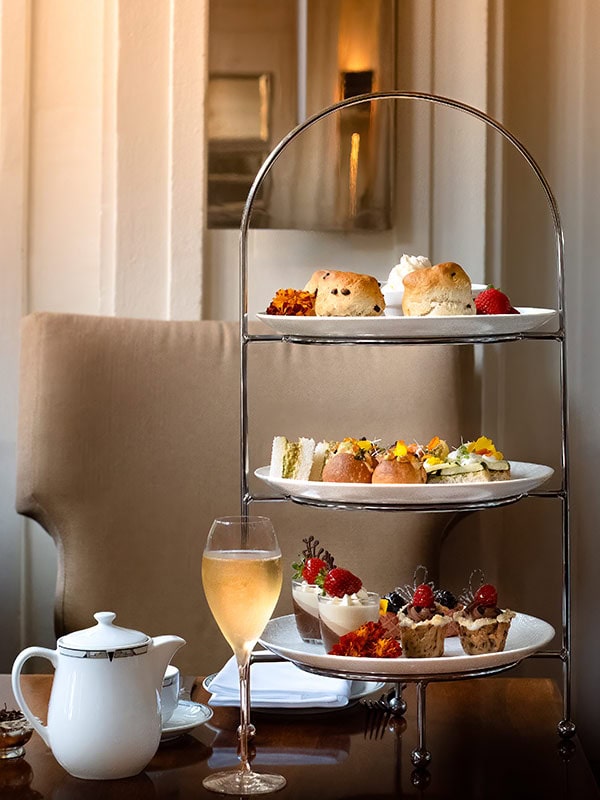
High Tea has been served since the 1920s.
The stool behind the shiny grand piano sits empty today, but I’m told if I were here on a Sunday afternoon, the piano player would be too. Clearly, a man dedicated to his work, Stuart has been tickling the ivories here for 35 years.
While Stuart is usually in charge of the live entertainment, I hear of an evening long ago during the late Supper Club hours when a guest took command of the piano and entertained the crowd for over two hours. It turns out that guest was the late, legendary Barry Humphries. Apparently, a lot of faces you might recognise often wander by.
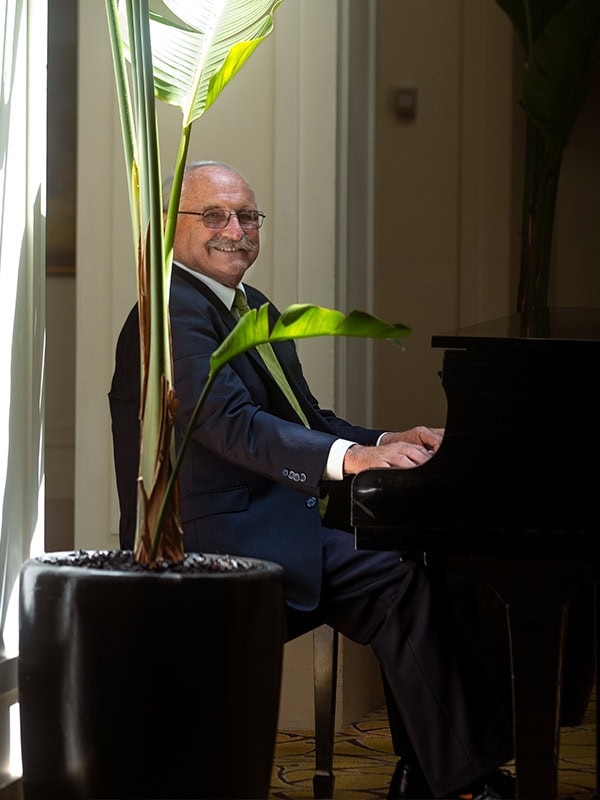
Stuart has been serenading guests with the piano for 35 years.
The Tea Lounge offers traditional dining in the evening too. A solid selection of local and Australian wines (with some international selections) is available by the glass. There are spirits and cocktails if you prefer, with a more elite spirit selection by the bottle.
If unrestricted dining is more your thing, The Promenade Cafe down the corridor offers buffet dining – aka The Grazing Table – from Tuesday to Thursday nights. It’s proving popular with locals, a fact I confirm while chatting to one who tells me she comes here every week for the buffet.
Along with a wide-ranging spread of hot and cold choices to suit any palate, the live pasta station adds a little theatre. Choose the alfredo sauce and you can opt to have your pasta whisked around the 40-kilogram parmesan block for even more cheese. Of course, I take that option. An indulgent seafood buffet with prawns and oysters galore is available on Friday and Saturday nights.
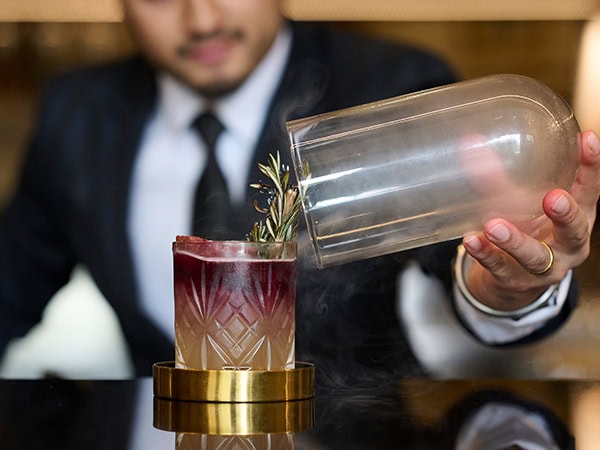
Try the delicious curated cocktails.
I’m back at the buffet the next morning; a generous affair covering all breakfast options and preferences. The pasta station now whips up eggs and omelettes ‘a la minute’, fresh and just how you like them. It’s a welcome addition to any breakfast setting. A selection of four different poached fruits, all spiced differently, is the early morning highlight for me, and a cappuccino to finish.
Does Hyatt Hotel Canberra have access for guests with disabilities?
The hotel offers specifically equipped accessible rooms.
Is Hyatt Hotel Canberra family-friendly?
Yes, children of all ages are welcome to stay and are well catered for.
Details
Best for: Those seeking a relaxing, luxurious and ultimately unforgetable stay.
Address: 120 Commonwealth Ave, Yarralumla ACT
Phone: (02) 6270 1234
Cost: From $695 per night.
The post Hyatt Hotel Canberra: a gem in the nation’s capital appeared first on Australian Traveller.


